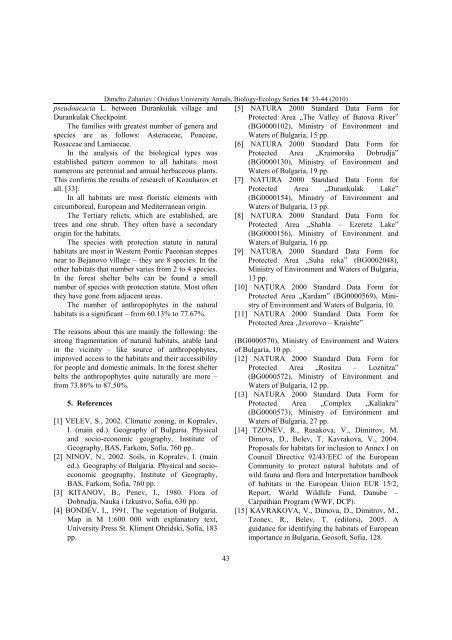VOLUM OMAGIAL - Facultatea de Ştiinţe ale Naturii şi Ştiinţe Agricole
VOLUM OMAGIAL - Facultatea de Ştiinţe ale Naturii şi Ştiinţe Agricole
VOLUM OMAGIAL - Facultatea de Ştiinţe ale Naturii şi Ştiinţe Agricole
Create successful ePaper yourself
Turn your PDF publications into a flip-book with our unique Google optimized e-Paper software.
Dimcho Zahariev / Ovidius University Annals, Biology-Ecology Series 14: 33-44 (2010)<br />
pseudoacacia L. between Durankulak village and<br />
Durankulak Checkpoint.<br />
The families with greatest number of genera and<br />
species are as follows: Asteraceae, Рoaceae,<br />
Rosaceae and Lamiaceae.<br />
In the analysis of the biological types was<br />
established pattern common to all habitats: most<br />
numerous are perennial and annual herbaceous plants.<br />
This confirms the results of research of Kozuharov et<br />
all. [33].<br />
In all habitats are most floristic elements with<br />
circumboreal, European and Mediterranean origin.<br />
The Tertiary relicts, which are established, are<br />
trees and one shrub. They often have a secondary<br />
origin for the habitats.<br />
The species with protection statute in natural<br />
habitats are most in Western Pontic Paeonian steppes<br />
near to Bejanovo village – they are 8 species. In the<br />
other habitats that number varies from 2 to 4 species.<br />
In the forest shelter belts can be found a small<br />
number of species with protection statute. Most often<br />
they have gone from adjacent areas.<br />
The number of anthropophytes in the natural<br />
habitats is a significant – from 60.13% to 77.67%.<br />
The reasons about this are mainly the following: the<br />
strong fragmentation of natural habitats, arable land<br />
in the vicinity – like source of anthropophytes,<br />
improved access to the habitats and their accessibility<br />
for people and domestic animals. In the forest shelter<br />
belts the anthropophytes quite naturally are more –<br />
from 73.86% to 87.50%.<br />
5. References<br />
[1] VELEV, S., 2002. Climatic zoning, in Kopr<strong>ale</strong>v,<br />
I. (main ed.). Geography of Bulgaria. Physical<br />
and socio-economic geography, Institute of<br />
Geography, BAS, Farkom, Sofia, 760 pp.<br />
[2] NINOV, N., 2002. Soils, in Kopr<strong>ale</strong>v, I. (main<br />
ed.). Geography of Bulgaria. Physical and socioeconomic<br />
geography, Institute of Geography,<br />
BAS, Farkom, Sofia, 760 pp.<br />
[3] KITANOV, B., Penev, I., 1980. Flora of<br />
Dobrudja, Nauka i Izkustvo, Sofia, 630 pp.<br />
[4] BONDEV, I., 1991. The vegetation of Bulgaria.<br />
Map in М 1:600 000 with explanatory text,<br />
University Press St. Kliment Ohridski, Sofia, 183<br />
pp.<br />
43<br />
[5] NATURA 2000 Standard Data Form for<br />
Protected Area „The Valley of Batova River”<br />
(BG0000102), Ministry of Environment and<br />
Waters of Bulgaria, 15 pp.<br />
[6] NATURA 2000 Standard Data Form for<br />
Protected Area „Kraimorska Dobrudja”<br />
(BG0000130), Ministry of Environment and<br />
Waters of Bulgaria, 19 pp.<br />
[7] NATURA 2000 Standard Data Form for<br />
Protected Area „Durankulak Lake”<br />
(BG0000154), Ministry of Environment and<br />
Waters of Bulgaria, 13 pp.<br />
[8] NATURA 2000 Standard Data Form for<br />
Protected Area „Shabla – Ezeretz Lake”<br />
(BG0000156), Ministry of Environment and<br />
Waters of Bulgaria, 16 pp.<br />
[9] NATURA 2000 Standard Data Form for<br />
Protected Area „Suha reka” (BG0002048),<br />
Ministry of Environment and Waters of Bulgaria,<br />
13 pp.<br />
[10] NATURA 2000 Standard Data Form for<br />
Protected Area „Kardam” (BG0000569), Ministry<br />
of Environment and Waters of Bulgaria, 10.<br />
[11] NATURA 2000 Standard Data Form for<br />
Protected Area „Izvorovo – Kraishte”<br />
(BG0000570), Ministry of Environment and Waters<br />
of Bulgaria, 10 pp.<br />
[12] NATURA 2000 Standard Data Form for<br />
Protected Area „Rositza – Loznitza”<br />
(BG0000572), Ministry of Environment and<br />
Waters of Bulgaria, 12 pp.<br />
[13] NATURA 2000 Standard Data Form for<br />
Protected Area „Complex „Kaliakra”<br />
(BG0000573), Ministry of Environment and<br />
Waters of Bulgaria, 27 pp.<br />
[14] TZONEV, R., Rusakova, V., Dimitrov, М.<br />
Dimova, D., Belev, T. Kavrakova, V., 2004.<br />
Proposals for habitats for inclusion to Annex I on<br />
Council Directive 92/43/EEC of the European<br />
Community to protect natural habitats and of<br />
wild fauna and flora and Interpretation handbook<br />
of habitats in the European Union EUR 15/2,<br />
Report, World Wildlife Fund, Danube –<br />
Carpathian Program (WWF, DCP).<br />
[15] KAVRAKOVA, V., Dimova, D., Dimitrov, М.,<br />
Tzonev, R., Belev, T. (editors), 2005. A<br />
guidance for i<strong>de</strong>ntifying the habitats of European<br />
importance in Bulgaria, Geosoft, Sofia, 128.





